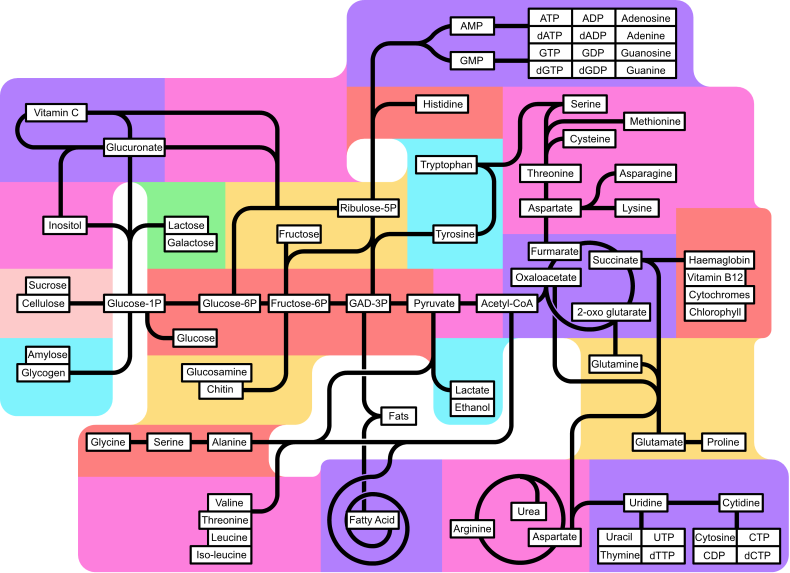Fruktoliza — разлика између измена
. |
(нема разлике)
|
Верзија на датум 9. мај 2018. у 02:30
Један корисник управо ради на овом чланку. Молимо остале кориснике да му допусте да заврши са радом. Ако имате коментаре и питања у вези са чланком, користите страницу за разговор.
Хвала на стрпљењу. Када радови буду завршени, овај шаблон ће бити уклоњен. Напомене
|
Fruktoliza se odnosi na metabolizam fruktoze iz prehrambenih izvora. Though the metabolism of glucose through glycolysis uses many of the same enzymes and intermediate structures as those in fructolysis, the two sugars have very different metabolic fates in human metabolism. Unlike glucose, which is metabolized widely in the body, fructose is metabolized almost completely in the liver in humans, where it is directed toward replenishment of liver glycogen and triglyceride synthesis.[1] Under one percent of ingested fructose is directly converted to plasma triglyceride.[2] 29% - 54% of fructose is converted in liver to glucose, and about quarter of fructose is converted to lactate. 15% - 18% is converted to glycogen.[3] Glucose and lactate are then used normally as energy to fuel cells all over the body.[2]
Fruktoza je prehrambeni monosaharid prirodno prisutan u voću i povrćus, either as free fructose or as part of the disaccharide sucrose, and as its polymer inulin. It is also present in the form of refined sugars including granulated sugars (white crystalline table sugar, brown sugar, confectioner's sugar, and turbinado sugar), refined crystalline fructose and as high fructose corn syrups. About 10% of the calories contained in the Western diet are supplied by fructose (approximately 55 g/day).[4]
Za razliku od glukoze, fruktoza nije insulinski secretagogue, and can in fact lower circulating insulin.[5] In addition to liver, fructose is metabolized in intestine, testis, kidney, skeletal muscle, fat tissue and brain,[6][7] but it is not transported into cells via insulin-sensitive pathways (insulin regulated transporters GLUT1 and GLUT4). Instead fructose is taken in by GLUT5.
Reference
- ^ McGrane, MM (2006). Carbohydrate Metabolism: is and Oxidation. Missouri: Saunders, Elsevier. стр. 258—277.
- ^ а б http://www.nutritionandmetabolism.com/content/9/1/89
- ^ Rippe, JM; Angelopoulos, TJ (2013). „Sucrose, high-fructose corn syrup, and fructose, their metabolism and potential health effects: what do we really know?”. Adv Nutr. 4: 236—45. PMC 3649104
 . PMID 23493540. doi:10.3945/an.112.002824.
. PMID 23493540. doi:10.3945/an.112.002824.
- ^ https://www.inkling.com/read/illustrated-reviews-biochemistry-harvey-5th/chapter-12/fructose-metabolism
- ^ http://press.endocrine.org/doi/abs/10.1210/jc.2003-031855
- ^ Douard, V; Ferraris, R. P. (2008). „Regulation of the fructose transporter GLUT5 in health and disease”. AJP: Endocrinology and Metabolism. 295 (2): E227—37. PMC 2652499
 . PMID 18398011. doi:10.1152/ajpendo.90245.2008.
. PMID 18398011. doi:10.1152/ajpendo.90245.2008.
- ^ Hundal, H. S.; Darakhshan, F; Kristiansen, S; Blakemore, S. J.; Richter, E. A. (1998). „GLUT5 expression and fructose transport in human skeletal muscle”. Advances in Experimental Medicine and Biology. 441: 35—45. PMID 9781312. doi:10.1007/978-1-4899-1928-1_4.
Spoljašnje veze
- The Entry of Fructose and Galactose into Glycolysis, Chapter 16.1.11. Biochemistry, 5th edition, Jeremy M Berg, John L Tymoczko, and Lubert Stryer, New York: W H Freeman; 2002.
- Tappy, L; Lê, K. A. (2010). „Metabolic effects of fructose and the worldwide increase in obesity”. Physiological Reviews. 90 (1): 23—46. PMID 20086073. doi:10.1152/physrev.00019.2009.

